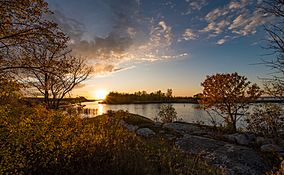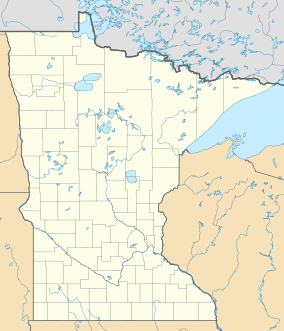Zippel Bay State Park facts for kids
Quick facts for kids Zippel Bay State Park |
|
|---|---|

The entrance to Zippel Bay on Lake of the Woods, from Zippel Bay State Park
|
|
| Location | Lake of the Woods County, Minnesota, United States |
| Area | 2,906 acres (11.76 km2) |
| Elevation | 1,083 ft (330 m) |
| Established | 1959 |
| Named for | Wilhelm Zippel |
| Visitors | 23109 |
| Governing body | Minnesota Department of Natural Resources |
| Website | Zippel Bay State Park |
Zippel Bay State Park is a fun state park in Lake of the Woods County, Minnesota. It sits right on the beautiful white sand beach of Lake of the Woods. This lake is very close to the border between the United States and Canada. You can visit the park all year long for exciting activities. These include camping, hiking, fishing, and cross-country skiing.
Contents
History of Zippel Bay State Park
The area around Zippel Bay has a long and interesting history. People have lived here since prehistoric times. Evidence of their old settlements has been found along the Rainy River. This river is just east of the bay.
Early Explorers and Fur Trade
The first Europeans to arrive were French explorers from New France. A type of French-Canadian explorer called a coureur des bois named Pierre La Vérendrye traveled through this area in 1732. He reported seeing Native American tribes like the Cree, Monsoni, Dakota, and Assiniboine. Later, the Ojibwe people moved into this area.
La Vérendrye built a small trading post called Fort St. Pierre on the Rainy River. He then built a stronger French base at Fort St. Charles. This fort was on what is now called Magnuson's Island. From here, French-Canadian travelers explored a large part of North America. They built other forts and traded furs. The money from the fur trade was very important for the economy of the French colony.
The best time for the French-Canadian fur trade lasted about 30 years. Then, the French had to leave their forts after the French and Indian War in 1763. This meant the area came under British rule.
Changing Borders and New Settlers
The area became part of the United States after the American Revolutionary War. This happened when the Treaty of Paris was signed in 1783. But the exact border was not clear until 1842. There was confusion about where the "northwest corner of Lake of the Woods" was located. After 50 years of debate, the official border was finally set.
Wilhelm Zippel was one of the first people to settle permanently in the area. He moved there in 1887 and built his home on a piece of land near Zippel Bay. Wilhelm and his family started a business catching fish in the lake. A small fishing village grew in the area and was busy by 1909. This village had a post office, a building for cold storage, and homes for the fishermen. Today, you can only see small signs of the village, like old foundations and dips in the ground.
Establishing the State Park
Zippel Bay State Park was created in 1959. The main goal was to give people public access to Lake of the Woods. It also aimed to offer fun outdoor activities. Building the park started in 1963 and was finished in 1967.
Nature and Wildlife at Zippel Bay
Zippel Bay State Park is home to many different plants and animals. You can find jack pine, birch, and quaking aspen trees here. Other plants include choke cherries, blueberries, cranberries, juneberries, pin cherries, strawberries, and mushrooms.
Animals of the Park
The plants attract animals that eat plants, like western moose and Dakota white-tailed deer. Other animals living in the park include eastern black bears, northeastern coyotes, Hudson Bay minks, fishers, and North American river otters. The American marten is also here, but it is rarely seen. You might even spot eastern wolves in this park.
Birds of the Lake and Bay
The shoreline of Lake of the Woods attracts many different birds. You can see shorebirds, water fowl, and birds of prey. Sandhill cranes build their nests on the north side of Zippel Bay. The bay is one of only four known places where the rare piping plover breeds. This plover is almost gone from the Great Lakes area of North America.
Other birds in the park include American white pelicans, Franklin's and Bonaparte's gulls, double-crested cormorants, and several types of terns. Ospreys and bald eagles also build their nests inside this park.
Geology of Zippel Bay
Zippel Bay State Park is in a part of Minnesota that was once covered by a huge glacial lake called Lake Agassiz. Lake of the Woods is what remains of that ancient glacial lake. The history of glaciers in northern Minnesota created areas of peatlands and sandy soil rich in minerals.
The land in the area is mostly gently sloped. However, there are some sudden slopes that used to be beaches of Lake of the Woods. You can also see several rock outcrops scattered along the shores of the lake and the bay.
Fun Activities at Zippel Bay
Zippel Bay State Park is open all year for fun activities. Fishing is the most popular thing to do here. Lake of the Woods has lots of walleye and sauger. Sauger are smaller relatives of the walleye. Other fish you can catch in the lake at the park include perch, muskellunge, and smallmouth bass.
The History of Sturgeon Fishing
Lake sturgeon are rarely caught today. But they were very important in the park's history. Wilhelm Zippel built his fishing business by catching sturgeon. These sturgeon were caught for their valuable eggs, called caviar. The fish could weigh up to 250 pounds (110 kg) and live for 100 years! Anglers sometimes still catch these huge fish at the park.
Camping and Trails
Zippel Bay State Park has two campgrounds with 57 campsites. There is also one group camping area for groups like the Boy Scouts. The camping areas have showers and toilets. There are also dumping stations for campers with recreational vehicles.
The park has 6 miles (9.7 km) of hiking trails. It also has 11 miles (18 km) of cross-country skiing trails and 3 miles (4.8 km) of snowmobile trails. Besides these, Zippel Bay State Park offers picnic areas with tables and a pavilion. There is also a swimming area, boat ramps, and a fishing pier.



